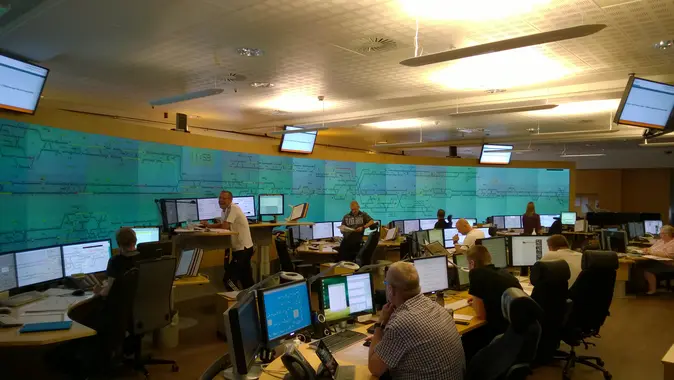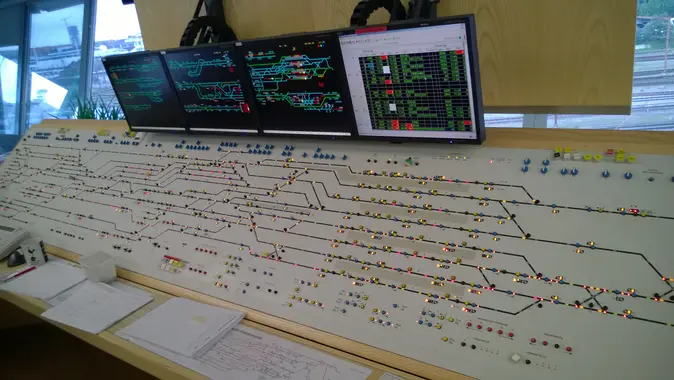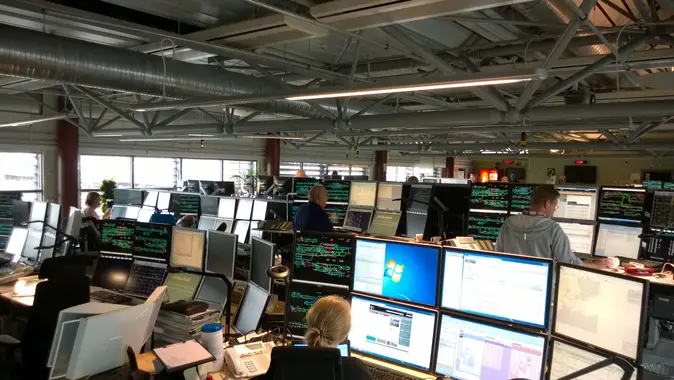Banedanmark runs Copenhagen’s urban railway network from this department: The company is responsible for the Danish rail network and operates track switches and signals. In Denmark, the state railroad was divided into two companies: Today, the Danske Staatsbaner operates passenger trains on all central routes.
One glance at the instrument panel of this Danish signal box and the complexities of modern rail traffic are clear. Nonetheless, the Danish rail network is still considered relatively simple.
Numerous monitors and simultaneously operating systems are required for employees of the Danske Staatsbaner to keep things running as smoothly as possible.
Foreign Solutions as Possible Models for the Deutsche Bahn
In Germany, nearly every third long-distance train arrives at its destination later than scheduled. Now, the German rail service, Deutsche Bahn, has pledged to improve punctuality. Professor Lasse Gerrits, Chair of Governance of Complex and Innovative Technological Systems, has conducted a multi-year research project analysing the ways in which railways across Europe deal with delays.
Using the network governance concept common in political science, Gerrits particularly focused on social relationships and their effects on operating procedures in Germany, Sweden, Belgium, Denmark, Austria and the Netherlands. This meant that for the first time, he was able to systematically analyse which disruption management solutions work and under which conditions. “There is no single best way to approach disruption management, but these countries can definitely learn something from each other,” says Gerrits.
The Deutsche Bahn could, for example, look to Sweden or Belgium for inspiration. In these countries, railway employees use simple, informal notification systems to quickly and precisely inform individual colleagues of disruptions. In Germany, similar communication requires filing specific forms and the use of prescribed channels.
The Dutch rail system has over 1,500 emergency plans that clearly define what should be done in specific cases. This often helps the responsible employees make split-second decisions and avoid more extensive impairment of rail services. The Deutsche Bahn only has a few contingency plans on hand and tends to rely on employees’ judgement and experience in cases of emergency. Gerrits, however, points out that this can also be an advantage, stating, “Plans can turn into traps. It’s impossible to anticipate everything, so it depends on whether or not a person is capable of spontaneously deviating from a plan and adapting it to a concrete situation in real-time.”
Advantages of the Deutsche Bahn: decentral organisation and extensive rail network
Gerrits’ research also shows that, contrary to popular opinion, the rail system in Germany functions better than many seem to think. For example, the Deutsche Bahn stands out due to its decentral organisation – a feature that provides clearly defined authority in operational disruptions and helps to avoid responsibility disputes.
Moreover, the Deutsche Bahn has one clear advantage over neighbouring countries: being Europe’s largest rail network with over 30,000 kilometres of tracks. This usually means that there are various options available for dealing with unforeseen disruptions. A train can often be re-routed, say, if another locomotive breaks down and blocks a certain section of track.
Lasse Gerrits’ project was conducted over a five-year span and received a total of € 600,000 in funding from the Dutch railway company ProRail and the Dutch research association NOW. The railway companies granted him access to the respective control rooms as well as to the employees working there.
Publication:
Lasse Gerrits, Danny Schipper. 2018. Internationale Vergleichsstudie zum Eisenbahnstörungsmanagement. https://doi.org/10.20378/irbo-52592
Further information on the content, methodology and findings of Lasse Gerrits’ study:
www.uni-bamberg.de/en/news/artikel/disruption-management
www.uni-bamberg.de/news/artikel/ergebnisse-stoerungsmanagement-bahn
Additional information for media representatives:
Contact information for content-related queries:
Prof. Dr. Dr. Lasse Gerrits
Chair of Governance of Complex and Innovative Technological Systems
Tel.: 0951/863-2737 od. -2738 (Sekr.)
lasse.gerrits(at)uni-bamberg.de
Media contact:
Tanja Eisenach
Pressereferentin
Tel.: 0951/863-1023
presse(at)uni-bamberg.de
This pressrelease was translated by Benjamin Wilson.


